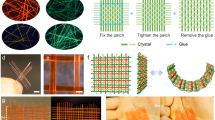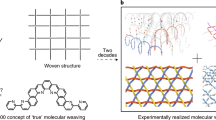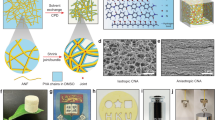Abstract
Fabrics—materials consisting of layers of woven fibres—are some of the most important materials in everyday life1. Previous nanoscale weaves2,3,4,5,6,7,8,9,10,11,12,13,14,15,16 include isotropic crystalline covalent organic frameworks12,13,14 that feature rigid helical strands interlaced in all three dimensions, rather than the two-dimensional17,18 layers of flexible woven strands that give conventional textiles their characteristic flexibility, thinness, anisotropic strength and porosity. A supramolecular two-dimensional kagome weave15 and a single-layer, surface-supported, interwoven two-dimensional polymer16 have also been reported. The direct, bottom-up assembly of molecular building blocks into linear organic polymer chains woven in two dimensions has been proposed on a number of occasions19,20,21,22,23, but has not previously been achieved. Here we demonstrate that by using an anion and metal ion template, woven molecular ‘tiles’ can be tessellated into a material consisting of alternating aliphatic and aromatic segmented polymer strands, interwoven within discrete layers. Connections between slowly precipitating pre-woven grids, followed by the removal of the ion template, result in a wholly organic molecular material that forms as stacks and clusters of thin sheets—each sheet up to hundreds of micrometres long and wide but only about four nanometres thick—in which warp and weft single-chain polymer strands remain associated through periodic mechanical entanglements within each sheet. Atomic force microscopy and scanning electron microscopy show clusters and, occasionally, isolated individual sheets that, following demetallation, have slid apart from others with which they were stacked during the tessellation and polymerization process. The layered two-dimensional molecularly woven material has long-range order, is birefringent, is twice as stiff as the constituent linear polymer, and delaminates and tears along well-defined lines in the manner of a macroscopic textile. When incorporated into a polymer-supported membrane, it acts as a net, slowing the passage of large ions while letting smaller ions through.
This is a preview of subscription content, access via your institution
Access options
Access Nature and 54 other Nature Portfolio journals
Get Nature+, our best-value online-access subscription
$29.99 / 30 days
cancel any time
Subscribe to this journal
Receive 51 print issues and online access
$199.00 per year
only $3.90 per issue
Buy this article
- Purchase on Springer Link
- Instant access to full article PDF
Prices may be subject to local taxes which are calculated during checkout





Similar content being viewed by others
Data availability
The data that support the findings of this study are available within the paper and its Supplementary Information, or are available from the Mendeley data repository (https://data.mendeley.com/) with the identifier https://doi.org/10.17632/zkt5km82r2.2.
References
Kadolph, S. J. (ed.) Textiles 10th edn (Prentice-Hall, 2007).
Batten, S. R. & Robson, R. Interpenetrating nets: ordered, periodic entanglement. Angew. Chem. Int. Ed. 37, 1460–1494 (1998).
Carlucci, L., Ciani, G. & Proserpio, D. M. Polycatenation, polythreading and polyknotting in coordination network chemistry. Coord. Chem. Rev. 246, 247–289 (2003).
Van Calcar, P. M., Olmstead, M. M. & Balch, A. L. Construction of a knitted crystalline polymer through the use of gold(i)–gold(i) interactions. Chem. Commun. 1773–1774 (1995).
Axtell, E. A., III, Liao, J.-H. & Kanatzidis, M. G. Flux synthesis of LiAuS and NaAuS: “Chicken-wire-like” layer formation by interweaving of (AuS)nn− threads. Comparison with α-HgS and AAuS (A = K, Rb). Inorg. Chem. 37, 5583–5587 (1998).
Carlucci, L., Ciani, G., Gramaccioli, A., Proserpio, D. M. & Rizzato, S. Crystal engineering of coordination polymers and architectures using the [Cu(2,2′-bipy)]2+ molecular corner as building block (bipy = 2,2′- bipyridyl). CrystEngComm 2, 154–163 (2000).
Li, Y.-H. et al. The first ‘two-over/two-under’ (2O/2U) 2D weave structure assembled from Hg-containing 1D coordination polymer chains. Chem. Commun. 1630–1631 (2003).
Han, L. & Zhou, Y. 2D entanglement of 1D flexible zigzag coordination polymers leading to an interwoven network. Inorg. Chem. Commun. 11, 385–387 (2008).
Wu, H., Yang, J., Su, Z.-M., Batten, S. R. & Ma, J.-F. An exceptional 54-fold interpenetrated coordination polymer with 103-srs network topology. J. Am. Chem. Soc. 133, 11406–11409 (2011).
Champsaur, A. M. et al. Weaving nanoscale cloth through electrostatic templating. J. Am. Chem. Soc. 139, 11718–11721 (2017).
Ciengshin, T., Sha, R. & Seeman, N. C. Automatic molecular weaving prototyped by using single-stranded DNA. Angew. Chem. Int. Ed. 50, 4419–4422 (2011).
Liu, Y. et al. Weaving of organic threads into a crystalline covalent organic framework. Science 351, 365–369 (2016).
Zhao, Y. et al. A synthetic route for crystals of woven structures, uniform nanocrystals, and thin films of imine covalent organic frameworks. J. Am. Chem. Soc. 139, 13166–13172 (2017).
Liu, Y. et al. Molecular weaving of covalent organic frameworks for adaptive guest inclusion. J. Am. Chem. Soc. 140, 16015–16019 (2018).
Lewandowska, U. et al. A triaxial supramolecular weave. Nat. Chem. 9, 1068–1072 (2017).
Wang, Z. et al. Molecular weaving via surface-templated epitaxy of crystalline coordination networks. Nat. Commun. 8, 14442 (2017).
Servalli, M. & Schlüter, A. D. Synthetic two-dimensional polymers. Annu. Rev. Mater. Res. 47, 361–389 (2017).
Mas-Ballesté, R., Gómez-Navarro, C., Gómez-Herrero, J. & Zamora, F. 2D materials: to graphene and beyond. Nanoscale 3, 20–30 (2011).
Busch, D. H. Structural definition of chemical templates and the prediction of new and unusual materials. J. Incl. Phenom. Macrocycl. Chem 12, 389–395 (1992).
Hubin, T. J. & Busch, D. H. Template routes to interlocked molecular structures and orderly molecular entanglements. Coord. Chem. Rev. 200–202, 5–52 (2000).
Cockriel, D. L. et al. The design and synthesis of pyrazine amide ligands suitable for the “tiles” approach to molecular weaving with octahedral metal ions. Inorg. Chem. Commun. 11, 1–4 (2008).
Wadhwa, N. R., Hughes, N. C., Hachem, J. A. & Mezei, G. Metal-templated synthesis of intertwined, functionalized strands as precursors to molecularly woven materials. RSC Adv. 6, 11430–11440 (2016).
Mena-Hernando, S. & Pérez, E. M. Mechanically interlocked materials. Rotaxanes and catenanes beyond the small molecule. Chem. Soc. Rev. 48, 5016–5032 (2019).
Forgan, R. S., Sauvage, J.-P. & Stoddart, J. F. Chemical topology: complex molecular knots, links, and entanglements. Chem. Rev. 111, 5434–5464 (2011).
Ayme, J.-F., Beves, J. E., Campbell, C. J. & Leigh, D. A. Template synthesis of molecular knots. Chem. Soc. Rev. 42, 1700–1712 (2013).
Sauvage, J.-P. From chemical topology to molecular machines (Nobel Lecture). Angew. Chem. Int. Ed. 56, 11080–11093 (2017).
Dietrich-Buchecker, C. O. & Sauvage, J.-P. A synthetic molecular trefoil knot. Angew. Chem. Int. Ed. Engl. 28, 189–192 (1989).
Chichak, K. S. et al. Molecular Borromean rings. Science 304, 1308–1312 (2004).
Guo, J., Mayers, P. C., Breault, G. A. & Hunter, C. A. Synthesis of a molecular trefoil knot by folding and closing on an octahedral coordination template. Nat. Chem. 2, 218–222 (2010).
Ayme, J.-F. et al. A synthetic molecular pentafoil knot. Nat. Chem. 4, 15–20 (2012).
Prakasam, T. et al. Simultaneous self-assembly of a [2]catenane, a trefoil knot, and a Solomon link from a simple pair of ligands. Angew. Chem. Int. Ed. 52, 9956–9960 (2013).
Wood, C. S., Ronson, T. K., Belenguer, A. M., Holstein, J. J. & Nitschke, J. R. Two-stage directed self-assembly of a cyclic [3]catenane. Nat. Chem. 7, 354–358 (2015).
Danon, J. J. et al. Braiding a molecular knot with eight crossings. Science 355, 159–162 (2017).
Zhang, L. et al. Stereoselective synthesis of a composite knot with nine crossings. Nat. Chem. 10, 1083–1088 (2018).
Leigh, D. A. et al. Tying different knots in a molecular strand. Nature 584, 562–568 (2020).
Ruben, M., Rojo, J., Romero-Salguero, F. J., Uppadine, L. H. & Lehn, J.-M. Grid-type metal ion architectures: functional metallosupramolecular arrays. Angew. Chem. Int. Ed. 43, 3644–3662 (2004).
Dawe, L. N., Abedin, T. S. M. & Thompson, L. K. Ligand directed self-assembly of polymetallic [n × n] grids: rational routes to large functional molecular subunits? Dalton Trans. 1661–1675 (2008).
Leigh, D. A. et al. A molecular endless (74) knot. Nat. Chem. https://doi.org/10.1038/s41557-020-00594-x (2020).
Pakula, A. A. & Simon, M. I. Determination of transmembrane protein structure by disulfide cross-linking: the Escherichia coli Tar receptor. Proc. Natl Acad. Sci. USA 89, 4144–4148 (1992).
Sakamoto, R. et al. Coordination nanosheets (CONASHs): strategies, structures and functions. Chem. Commun. 53, 5781–5801 (2017).
de Gennes, P. G. Reptation of a polymer chain in the presence of fixed obstacles. J. Chem. Phys. 55, 572–579 (1971).
Zhu, W. et al. Structure and electronic transport in graphene wrinkles. Nano Lett. 12, 3431–3436 (2012).
Young, R. J. & Lovell, P. A. Introduction to Polymers 3rd edn (CRC Press, 2011).
de Ruijter, C., Mendes, E., Boerstoel, H. & Picken, S. J. Orientational order and mechanical properties of poly(amide-block-aramid) alternating block copolymer films and fibers. Polymer 47, 8517–8526 (2006).
Kontturi, K., Murtomäki, L. & Manzanares, J. A. Ionic Transport Processes in Electrochemistry and Membrane Science (Oxford Univ. Press, 2014).
Li, G. et al. Woven polymer networks via the topological transformation of a [2]catenane. J. Am. Chem. Soc. 142, 14343–14349 (2020).
Hawker, C. J. & Wooley, K. L. The convergence of synthetic organic and polymer chemistries. Science 309, 1200–1205 (2005).
Sakamoto, J., van Heijst, J., Lukin, O. & Schlüter, A. D. Two-dimensional polymers: just a dream of synthetic chemists? Angew. Chem. Int. Ed. 48, 1030–1069 (2009).
Wu, Q. et al. Poly[n]catenanes: synthesis of molecular interlocked chains. Science 358, 1434–1439 (2017).
Stoddart, J. F. Dawning of the age of molecular nanotopology. Nano Lett. 20, 5597–5600 (2020).
Acknowledgements
We thank the Engineering and Physical Sciences Research Council (EPSRC; EP/P027067/1), the European Research Council (ERC; Advanced Grant no. 786630), and the Defense Advanced Research Projects Agency (DARPA; Co-operative Agreement W911NF-17-2-0148) for funding; with networking contributions from the COST Action CA17139, EUTOPIA. The views, opinions and/or findings expressed are those of the authors and should not be interpreted as representing the official views or policies of the Department of Defense or the US Government. We also thank the Diamond Light Source (UK) for synchrotron beam time on I19 (XR029), the University of Manchester, Department of Chemistry microanalysis and mass spectrometry services, the Henry Royce Institute for Advanced Materials (funded through EPSRC grants EP/R00661X/1 and EP/P025021/1) for the use of facilities, S. Jantzen/Biocinematics for the video animations, and S. J. Rowan (University of Chicago) and R. P. Sijbesma (Eindhoven University) for comments that improved the draft manuscript. D.A.L. is a Royal Society Research Professor.
Author information
Authors and Affiliations
Contributions
D.P.A., L.I.P., J.-F.L. and Y.S. carried out the synthesis and general characterization studies. G.F.S.W. solved the crystal structure of [Fe916](BF4)18. Z.L., C.A.M. and R.J.Y. carried out the AFM studies. Z.L. and R.J.Y. performed the Young’s modulus, polarized optical microscope and deformation experiments. S.J.H. conducted the transmission electron microscopy studies, and R.A.W.D. and P.R.C.K. conducted the ion permeation studies. D.A.L. directed the research. All authors contributed to the analysis of the results and the writing of the manuscript. Authors are listed alphabetically in view of the broad range of experimental techniques used in this study.
Corresponding author
Ethics declarations
Competing interests
The authors declare no competing interests.
Additional information
Peer review information Nature thanks the anonymous reviewer(s) for their contribution to the peer review of this work.
Publisher’s note Springer Nature remains neutral with regard to jurisdictional claims in published maps and institutional affiliations.
Supplementary information
Supplementary Information
Experimental procedures, methods and characterisation data.
Video 1
(MPEG-4) Animation of the assembly of the 2D molecularly woven fabric. Video credit: Stuart Jantzen (Biocinematics).
Video 2
Supplementary Video 2 (MPEG-4) - Animation of AFM of a layered sheet of the 2D molecularly woven fabric. Video credit: Stuart Jantzen (Biocinematics).
Video 3
Supplementary Video 3 (MPEG-4) - Animation of the fracturing and delamination process of a layered sheet of the 2D molecularly woven fabric on a polyester support under strain. Video credit: Stuart Jantzen (Biocinematics).
Video 4
Supplementary Video 4 (MPEG-4) - Animation of Young’s modulus determination by AFM on the 2D molecularly woven fabric and the corresponding unwoven linear polymer. Video credit: Stuart Jantzen (Biocinematics).
Video 5
Supplementary Video 5 (MPEG-4) - Animation of the ion permeability studies on PVDF-supported membranes formed from (i) the 2D molecularly woven fabric and (ii) the corresponding unwoven linear polymer. Video credit: Stuart Jantzen (Biocinematics).
Rights and permissions
About this article
Cite this article
August, D.P., Dryfe, R.A.W., Haigh, S.J. et al. Self-assembly of a layered two-dimensional molecularly woven fabric. Nature 588, 429–435 (2020). https://doi.org/10.1038/s41586-020-3019-9
Received:
Accepted:
Published:
Issue Date:
DOI: https://doi.org/10.1038/s41586-020-3019-9
This article is cited by
-
Mechanical scission of a knotted polymer
Nature Chemistry (2024)
-
Synthesis of nanoparticles based on wavy interlocked macrocycles template
Applied Physics A (2024)
-
Luminescent terpyridine-based metallo-supramolecular systems: from design to applications
Science China Chemistry (2023)
-
Controlling dynamics in extended molecular frameworks
Nature Reviews Chemistry (2022)
-
Self-assembly and photoinduced fabrication of conductive nanographene wires on boron nitride
Nature Communications (2022)
Comments
By submitting a comment you agree to abide by our Terms and Community Guidelines. If you find something abusive or that does not comply with our terms or guidelines please flag it as inappropriate.



